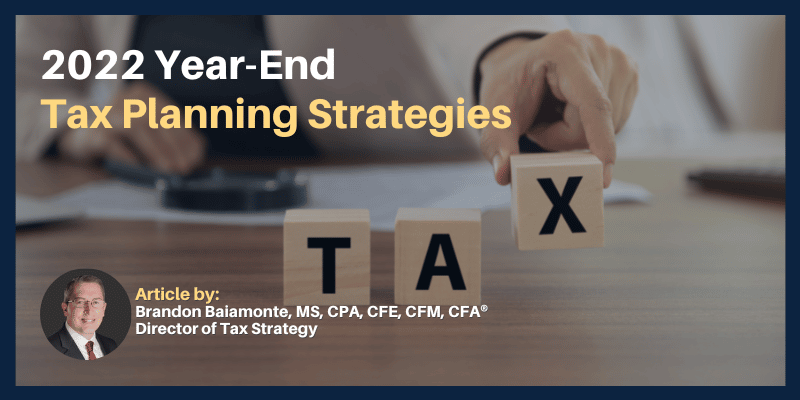
Charitable Contributions
There are several ways donating to charity can reduce your tax bill. The more common ways are:
- Donating cash directly to a charity.
- Donating household or personal items to charity. This may include clothing, furniture, and a host of other items.

- You can also donate appreciated stock directly to charity. You will receive a deduction of the market value of the stock as of the day you contribute the stock to the charity. This is a way of avoiding capital gains on the stock from selling it. You do need to have held the stock for at least a year for this strategy to work.
- Contribute to a donor-advised fund (DAF). You can set these accounts up at a variety of places including Fidelity and Schwab. The DAF is a 501(c)(3) organization, so any donations generate an immediate tax deduction. The benefit is you can then decide which public charities your DAF sends money to. These withdrawals to public charities don’t need to be made in the same year. This is a way of making donations to charities in the future while getting a current tax deduction. You may want to donate to a DAF in a year where your income is higher than it will be in the future.
- Many people take the standard deduction or barely itemize their deductions. You can reduce your tax bill by “bunching” several years of donations in a single year. Contributions to a DAF are a great way of using this technique.
- A qualified charitable distribution (QCD) is where funds go directly from your individual retirement account (IRA) to a public charity. The amount that goes to charity isn’t taxable. This is a great way for clients who are taking required minimum distributions (RMD’s) to reduce the IRA distribution amount that is taxable. You need to be at least 70 ½ to use this strategy, but we generally recommend you wait until age 72 or when you are required to take out distributions.
- A charitable remainder trust (CRT) is a more advanced planning strategy but can be very useful for certain individuals. This is where you set up a CRT and then contribute (usually significantly appreciated assets) into it. You get an immediate charitable deduction of approximately 20% to 40% of the amount you contributed. You then get an income stream over a period of years (even for the rest of your life). After that time passes, the remainder of what’s left in the trust goes to the charity or charities of your choice.
Required Minimum Distributions (RMD’s)
It’s a good idea to ensure you have taken out your RMD (if you are required to) by the end of the year. RMD’s are now required to be started when you reach age 72. The penalties are stiff and so it’s something you don’t want to miss.
Harvesting Losses
It’s been a tough year in the stock and bond markets and some of our investments have decreased in value. You can realize a tax loss by selling an investment that has decreased in value from when it was purchased. This loss can be used to offset other capital gains or ordinary income up to $3,000.
There are wash sale rules that don’t allow you to take the loss if you repurchase the same asset within 30 days, so be sure to consult with your advisor about this specific strategy.
Please refer to the ‘What is Tax Loss Harvesting?’ article in this newsletter for more information on this topic.
Retirement Account Contributions
You may have several retirement and other accounts you can contribute to. It’s a good idea to have a plan of how much you want to contribute and then evaluate your progress. If you are able, then you should consider contributing the maximum amount allowed.
- Individual retirement account (IRA) – you can contribute up to $6,000 ($7,000 if you’re age 50 or older). There are certain income limitations that need to be met to qualify for a tax deduction. These income limits are also affected by whether you have access to a retirement plan at work.
- Roth IRA – you can contribute up to $6,000 ($7,000 if you’re age 50 or older). There are income limitations that apply.
The phaseout ranges are:
- Single $129,000 to $144,000
- Married Joint $204,000 to $214,000
- 401(k) contributions – you can contribute up to $20,500 to a 401(k) plan. You can make an additional catch-up contribution of $6,500 if you are age 50 or older.
- Health savings account (HSA) contributions – you can contribute $3,650 for self-only or $7,300 for family coverage. You can also make an additional $1,000 contribution if you’re age 55 or older. You must have a qualified high-deductible medical plan to open and contribute to an HSA.
There are numerous retirement plan options to choose from if you are self-employed or own a business. It’s best to speak with your financial adviser or CPA to discuss these options. Several options include a SEP plan, 401(k) plan if you have employees, solo 401(k) plan if you don’t have any employees, defined benefit plans, etc.
Roth Conversions
A Roth conversion is where you take funds held in an IRA account and convert them to a Roth IRA. Roth conversions are taxed at ordinary income tax rates and increase your tax bill. You might be wondering what the benefit is to paying more in taxes. The answer, you could pay less taxes down the road. Some of the more important considerations include:
- Are you currently in a low marginal tax rate and do you anticipate being in a higher marginal income tax bracket in the future?
- You don’t need your full required minimum distribution (RMD) to support your lifestyle. There isn’t an RMD requirement for Roth accounts during your lifetime. A Roth conversion reduces your IRA account balance subject to RMD’s.
- It’s important to note that doing a Roth conversion can affect other areas on your tax return including your Medicare part B/D premiums, premium tax credit, the taxable portion of social security, etc.
- There are several factors to consider and so we recommend consulting with your financial adviser and CPA.
How Mission Wealth Can Help
At Mission Wealth, we help you explore the most cost-effective solutions to cover numerous possibilities. We are a fiduciary for our clients and have no proprietary products to sell, and no quotas to fill. We simply offer independent, objective advice that serves your best interests.
Our experience and resources can create a total coordinated picture. Our advisors will provide objective advice that aligns your financial position with your biggest dreams and aspirations.
Our Tax Management Services Include:
- Estate Tax Reduction Strategies
- Annual Tax Management Review (for Integrated Wealth and Private Clients)
- Concentrated Stock Planning (Access to LPs)
- Integration & Coordination with CPA on Tax Savings Strategies
- You can find more information by visiting missionwealth.com/tax-management.
Your client advisor at Mission Wealth is available to coordinate with your tax advisor and is a great resource to help plan for and implement this and other strategies.
If you don't have an advisor but would like to learn more, you can contact us by phone or via our website and an advisor will be in touch. Please visit www.missionwealth.com to learn more.
Copyright © 2022, Mission Wealth is a Registered Investment Advisor. All rights reserved.
ALL INFORMATION HEREIN HAS BEEN PREPARED SOLELY FOR INFORMATIONAL PURPOSES. ADVISORY SERVICES ARE ONLY OFFERED TO CLIENTS OR PROSPECTIVE CLIENTS WHERE MISSION WEALTH AND ITS REPRESENTATIVES ARE PROPERLY LICENSED OR EXEMPT FROM LICENSURE. PAST PERFORMANCE IS NO GUARANTEE OF FUTURE RETURNS. INVESTING INVOLVES RISK AND POSSIBLE LOSS OF PRINCIPAL CAPITAL. NO ADVICE MAY BE RENDERED BY MISSION WEALTH UNLESS A CLIENT SERVICE AGREEMENT IS IN PLACE.
00463643 09/22

